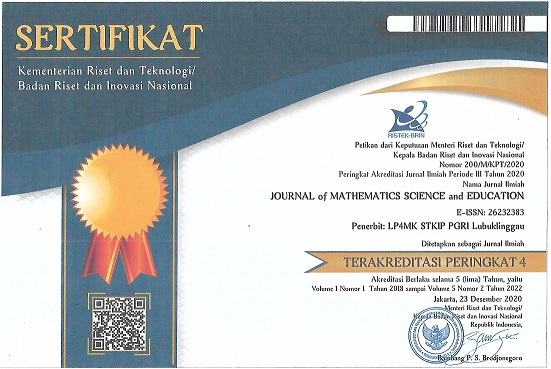DESAIN DIDAKTIS KONSEP BANGUN RUANG MATERI KUBUS UNTUK KELAS V SEKOLAH DASAR
Abstract
This study aim to make a didactical design on the concept of building a cube material in the 5th elementary school based on Learning Obstacle (LO). The approach used in this study is a qualitative approach with the DDR (Didactical Design Research) method which includes three stages, namely prospective analysis, metapedadidactic analysis, and retrospective analysis. The prospective analysis stage identifies the Learning Obstacles experienced by students in the cube material, including: 1) Ontogenic Obstacles, such as a lack of student interest in learning mathematics, only 50% of students in the class who like learning mathematics and lack of student mastery in prerequisite material; 2) Didactical Obstacle, namely the learning method used is still monotonous, the learning media is less varied and the teaching materials used are incomplete; 3) Epistemological Obstacle, namely students do not understand how to determine the volume of a cube, students do not understand problem solving strategies related to unit cubes. Based on the findings of LO, a Hypothetical Learning Trajectory (HLT) was compiled which was then designed a hypothetical didactic design on the concept of building cube material which includes four learning objectives, namely determining the area of a square, analyzing the elements of a cube, determining the volume of a cube, and completing problems related to the volume of a cube using the unit volume. The didactic design is applied by the method of snowball throwing and flashcard games. After the didactic design was implemented, the results of the LO of the final identificational test were decreased compared to the LO of the diagnostic test. The didactic design is one of the effective learning alternatives in reducing the appearance of LO in the concept of building a cube material in the 5th elementary school.
References
Fuadiah, N. F. (2017). Hypothetical Learning Trajectory Pada Pembelajaran Bilangan Negatif Berdasarkan Teori Situasi Didaktis di Sekolah Menengah. Mosharafa: Jurnal Pendidikan Matematika, 13-24.
Husein. (2020). Kesulitan Belajar pada Siswa Sekolah Dasar: Studi Kasus pada Sekolah Dasar Muhammaddiyah Karangwaru Yogyakarta. UIN Sunan Kalijaga Yogyakarta, 56-67.
Neolaka, A., & Neolaka, G. A. (2017). Landasan Pendidikan. Jakarta: Kencana.
Nurdiana, I., & Murjainah. (2017). Hubungan Penggunaan Media Scrapbook dengan Motivasi Belajar Geografi Siswa Kelas VII di SMP Negeri 41 Palembang. Edutech, 274-287.
Putri, B. B., Muslim, A., & Bintaro, T. Y. (2019). Analisis Faktor Rendahnya Minat Belajar Siswa Kelas V di SD Negeri 4 Gumiwang. Jurnal Educatio FKIP UNMA, 68-74.
Sugiyono. (2013). Metode Penelitian Kuantitatif, Kualitatif dan R&D. Bandung: Alfabeta.
Sugiyono. (2020). Metode Penelitan Kualitatif. Bandung: Alfabeta.
Suryadi, D. (2019). Monograf 2 : Didactical Design Research (DDR). Bandung: Gapura Press.
Suryadi, D. (2019). Penelitian Desain Didaktis (DDR) dan Implementasinya. Bandung: Gapura Press.
Susanto, A. (2019). Teori Belajar dan Pembelajaran di Sekolah. Jakarta : Kencana Prenadamedia Group.
Widiawati, W. (2020). Desain Didaktis Konsep Volume Balok dan Kubus untuk Mengembangkan Kemampuan Abstraksi Matematis Siswa Kelas V Sekolah Dasar. Bandung: Universitas Pendidikan Indonesia.
Zulfikar, H. A., Suryana, Y., & Lidinillah, D. A. (2018). Desain Didaktis Volume Kubus dan Balok untuk Mengembangkan Kemampuan Berpikir Kritis Siswa Kelas V Sekolah Dasar. Pedadidaktika: Jurnal Ilmiah Pendidikan Guru Sekolah Dasar, 62-73.

This work is licensed under a Creative Commons Attribution-NonCommercial-ShareAlike 4.0 International License.

This work by Journal of Mathematics Science and Education is licensed under a Creative Commons Attribution-NonCommercial-ShareAlike 4.0 International License.


















